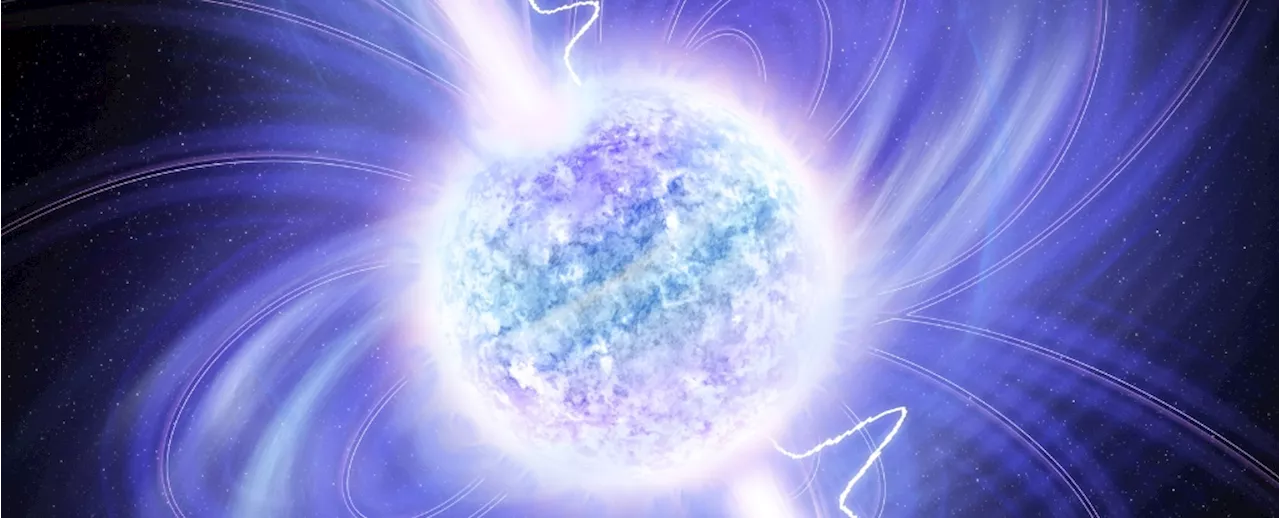Astronomers have discovered the slowest rotating pulsar yet, named ASKAP J1839-0756. This object spins once every 6.5 hours and emits radio pulses from both its magnetic poles, a rare phenomenon never seen before in such slowly spinning objects. This discovery challenges our understanding of neutron stars and opens new avenues for exploring their behavior.
When some of the biggest stars reach the end of their lives, they explode in spectacular supernovas and leave behind incredibly dense cores called neutron stars . Some of these remnants emit powerful radio beams from their magnetic poles. As the star spins, these beams sweep past Earth and produce periodic pulses of radio waves, much like a cosmic lighthouse. This behavior has earned them the name 'pulsars'.
Pulsars typically spin incredibly fast, often completing a full rotation in just seconds – or even less. Over the last three years, some mysterious objects have emerged that emit periodic radio pulses at much slower intervals, which is hard to explain with our current understanding of neutron stars. In new research, we have found the slowest cosmic lighthouse yet – one that spins once every 6.5 hours. This discovery, named ASKAP J1839-0756, is a game-changer for astrophysics. Our slow lighthouse also happens to be aligned with Earth in a way that lets us see radio pulses from both its magnetic poles. This rare phenomenon is a first for objects spinning this slowly and offers a new window into how these stars work. We discovered the object, named ASKAP J1839-0756, using CSIRO's ASKAP radio telescope, located in Wajarri Yamaji country in Western Australia. During a routine observation, ASKAP J1839-0756 stood out because no previously known object had been identified at its position. Its radio emission appeared as a fading burst, with its brightness plummeting by 95% in just 15 minutes. At first, we had no idea the source was emitting periodic radio pulses. Only a single burst had been detected during the initial observation. To uncover more, we conducted more observations with ASKAP as well as CSIRO's Australia Telescope Compact Array on Kamilaroi country in Narrabri, NSW, and the highly sensitive MeerKAT radio telescope in South Africa. A long ASKAP observation eventually revealed two pulses separated by 6.5 hours, confirming the periodic nature of the source. But here is the real surprise: according to what we know about neutron stars, ASKAP J1839-0756 shouldn't even exist. Neutron stars emit radio pulses by converting their rotational energy into radiation. Over time, they lose energy and slow down. If a neutron star's spin slows beyond a certain point (about one rotation per minute), it should stop emitting radio pulses altogether. Yet here is ASKAP J1839-0756, lighting up the cosmos at a leisurely pace of one rotation every 6.5 hours. The pulse detected by the MeerKAT telescope at two different centre frequencies is shown here. The upper plots show the pulse's brightness over time, while the lower plots illustrate the observing frequency over time, with colours representing brightness levels. (Yu Wing Joshua Lee)Most pulsars, the faster-spinning cousins of ASKAP J1839-0756, are like one-sided flashlights. The axis they spin around is closely aligned to the axis of their magnetic field, which means we only see flashes from one magnetic pole. But in about 3% of pulsars, the rotational and magnetic axes are almost at right angles to one another, which lets us see pulses from both poles. These rare double flashes, called interpulses, provide a unique window into the star's geometry and magnetic field. How the magnetic and rotational axes of ASKAP J1839-0756 become more aligned or less aligned as it slows down is still an open question. The interpulse from ASKAP J1839-0756 could provide clues to this question. About 3.2 hours after its main pulse, it emits a weaker pulse with different properties, strongly suggesting we're seeing radio light from the opposite magnetic pole. This discovery makes ASKAP J1839-0756 the first slowpoke in its class to emit interpulses, and it raises big questions about how such objects work. So, what is powering this cosmic anomaly? One possibility is that it is a magnetar – a neutron star with a powerful magnetic field that makes Earth's most powerful magnets look like featherweights. Magnetars generate radio pulses through a different mechanism, which might allow them to keep shining even at slower spin rates. But even magnetars have limits, and their periods are usually measured in seconds, not hours. The only exception is a magnetar named 1E 161348-5055, which has a period of 6.67 hours. However, it only emits X-ray and no radio pulses. White dwarfs spin much more slowly than neutron stars, but no individual isolated white dwarfs have been observed to emit radio pulses. And so far, no observations in other wavelengths have found evidence of a white dwarf at this location in the sky. Whatever ASKAP J1839-0756 turns out to be, it is clear that this object is rewriting the rulebook. Its strange combination of slow rotation, radio pulses and interpulses is forcing astronomers to rethink the limits of neutron star behavior and explore new possibilities for what lies at the heart of this enigma. The discovery of ASKAP J1839-0756 is a reminder that the universe loves to surprise us, especially when we think we have got it all figured out
Neutron Stars Pulsars Radio Astronomy Magnetars Astrophysics
United States Latest News, United States Headlines
Similar News:You can also read news stories similar to this one that we have collected from other news sources.
 Springdale business owners try to stay afloat amid Zion National Park's slowest seasonThe gateway town to Zion National Park sees a decline in business during the winter months, and the shop owners are working to keep their businesses afloat duri
Springdale business owners try to stay afloat amid Zion National Park's slowest seasonThe gateway town to Zion National Park sees a decline in business during the winter months, and the shop owners are working to keep their businesses afloat duri
Read more »
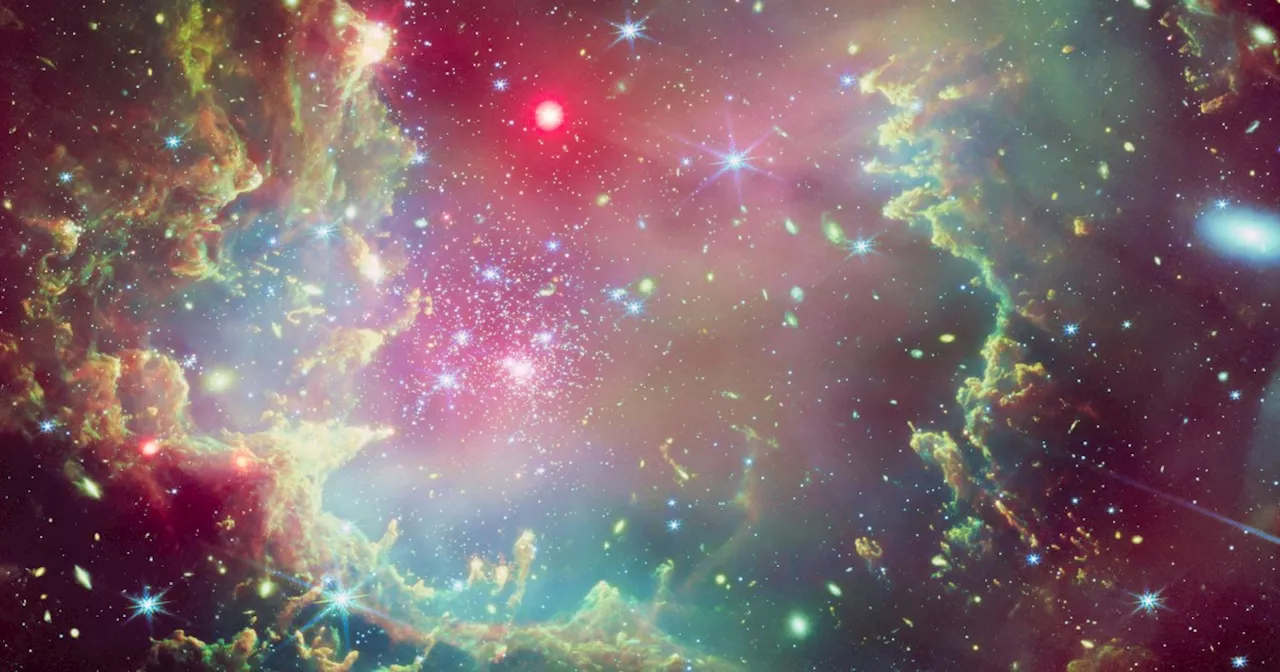 NASA Unveils Cosmic Wreath and Christmas Tree Cluster for the Holiday SeasonNASA celebrates the holidays with stunning images showcasing NGC 602, a star cluster resembling a cosmic wreath, and NGC 2264, nicknamed the 'Christmas Tree Cluster'. These images combine data from different telescopes, revealing insights into star formation and galaxy evolution.
NASA Unveils Cosmic Wreath and Christmas Tree Cluster for the Holiday SeasonNASA celebrates the holidays with stunning images showcasing NGC 602, a star cluster resembling a cosmic wreath, and NGC 2264, nicknamed the 'Christmas Tree Cluster'. These images combine data from different telescopes, revealing insights into star formation and galaxy evolution.
Read more »
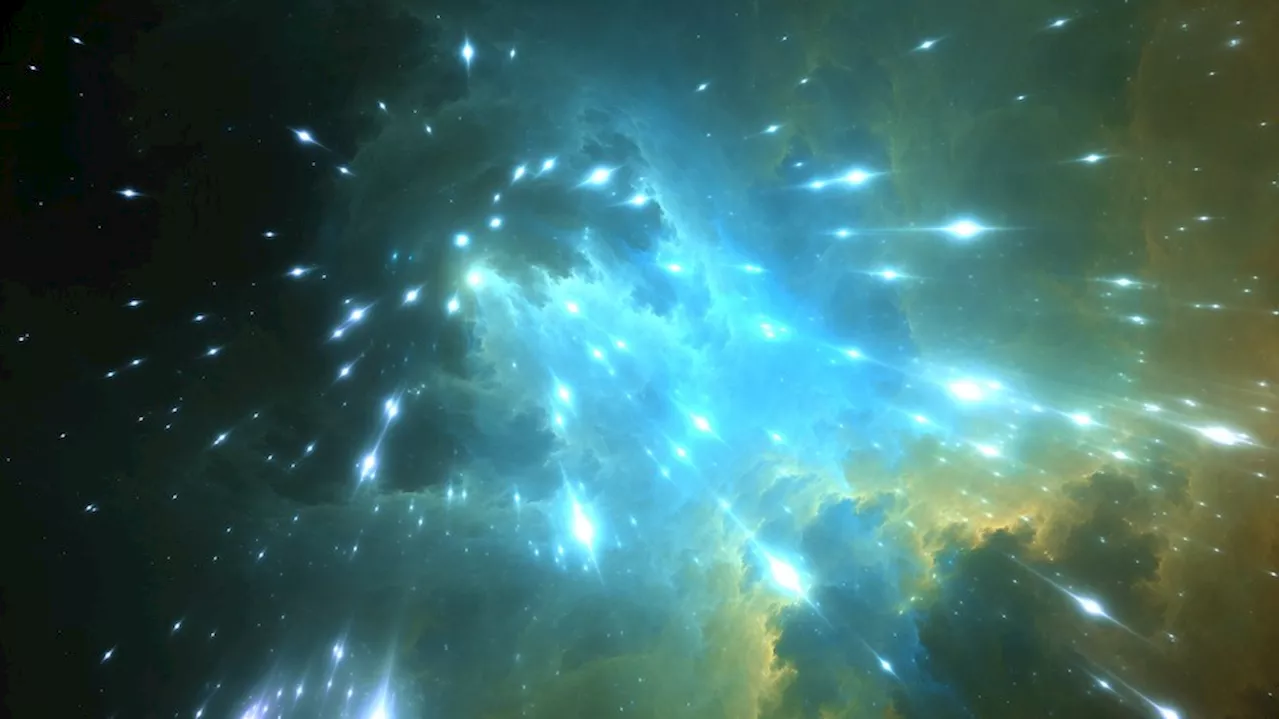 Ultra-High-Energy Cosmic Rays: Probing the Universe's Most Energetic EventsSpace, while seemingly empty, is traversed by ultra-high-energy cosmic rays, containing millions of times more energy than the Large Hadron Collider. These rays, thought to originate from the most energetic events in the universe like supernovae and active galactic nuclei, may be linked to magnetic turbulence. Studying these particles, which bombard Earth and produce secondary particles, helps scientists understand their origins and potential impact on Earth's climate and biodiversity.
Ultra-High-Energy Cosmic Rays: Probing the Universe's Most Energetic EventsSpace, while seemingly empty, is traversed by ultra-high-energy cosmic rays, containing millions of times more energy than the Large Hadron Collider. These rays, thought to originate from the most energetic events in the universe like supernovae and active galactic nuclei, may be linked to magnetic turbulence. Studying these particles, which bombard Earth and produce secondary particles, helps scientists understand their origins and potential impact on Earth's climate and biodiversity.
Read more »
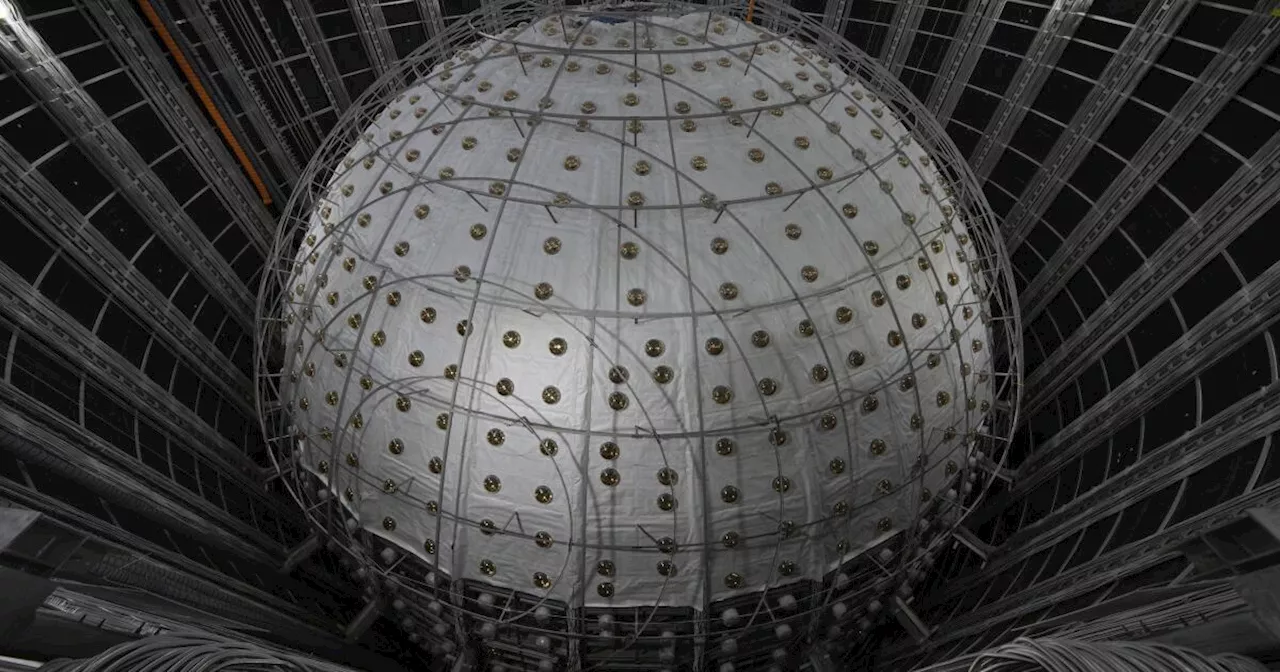 China's Giant Neutrino Detector Set to Unlock Cosmic SecretsA massive neutrino detector nearing completion in China promises to shed light on these elusive particles and their role in the universe's formation.
China's Giant Neutrino Detector Set to Unlock Cosmic SecretsA massive neutrino detector nearing completion in China promises to shed light on these elusive particles and their role in the universe's formation.
Read more »
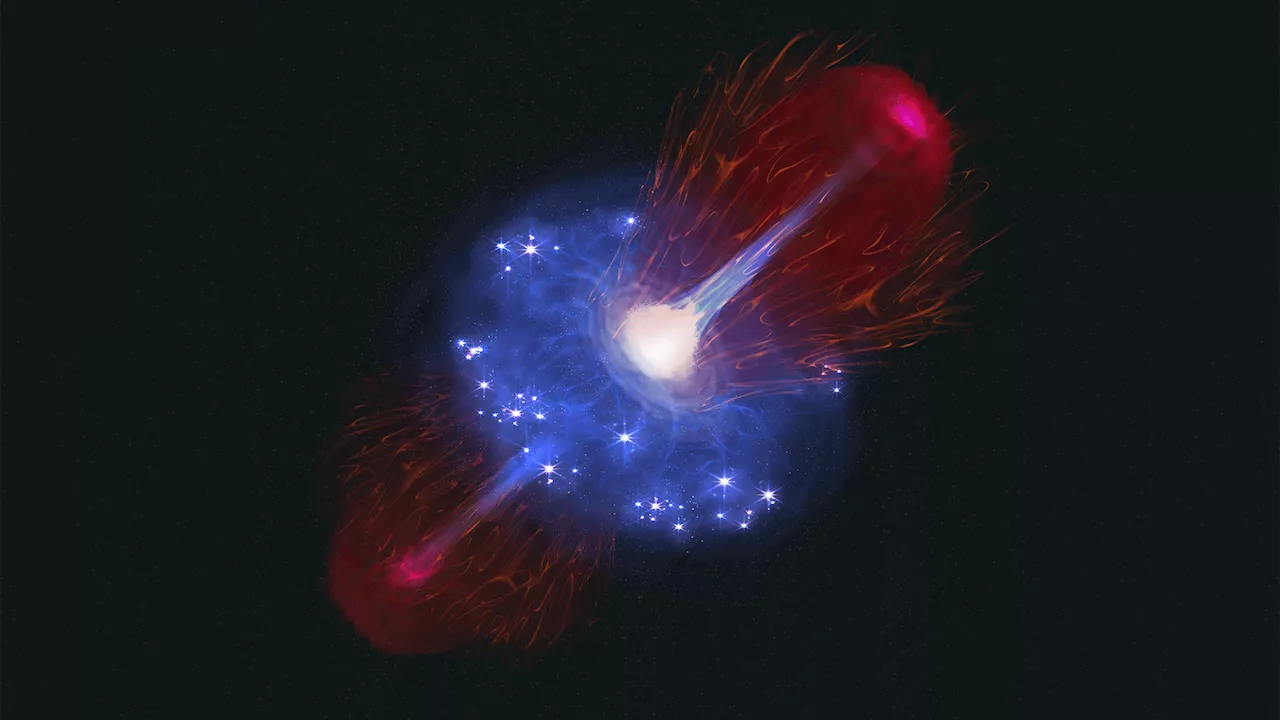 Dormant Black Hole Challenges Cosmic ModelsAstronomers using the James Webb Space Telescope (JWST) have observed a massive black hole in the early universe that is surprisingly inactive. This discovery challenges our understanding of black hole growth.
Dormant Black Hole Challenges Cosmic ModelsAstronomers using the James Webb Space Telescope (JWST) have observed a massive black hole in the early universe that is surprisingly inactive. This discovery challenges our understanding of black hole growth.
Read more »
![]() Cosmic Wreath and Christmas Tree Revealed by Chandra and WebbNASA's Chandra X-ray Observatory and the James Webb Space Telescope have combined their data to create stunning new images of two star clusters that resemble a cosmic wreath and a Christmas tree. NGC 602, the 'wreath,' is a stellar nursery in the Small Magellanic Cloud, offering insights into the early universe due to its composition of lightweight stars. NGC 2264, the 'Christmas tree,' is another cluster of young stars.
Cosmic Wreath and Christmas Tree Revealed by Chandra and WebbNASA's Chandra X-ray Observatory and the James Webb Space Telescope have combined their data to create stunning new images of two star clusters that resemble a cosmic wreath and a Christmas tree. NGC 602, the 'wreath,' is a stellar nursery in the Small Magellanic Cloud, offering insights into the early universe due to its composition of lightweight stars. NGC 2264, the 'Christmas tree,' is another cluster of young stars.
Read more »
